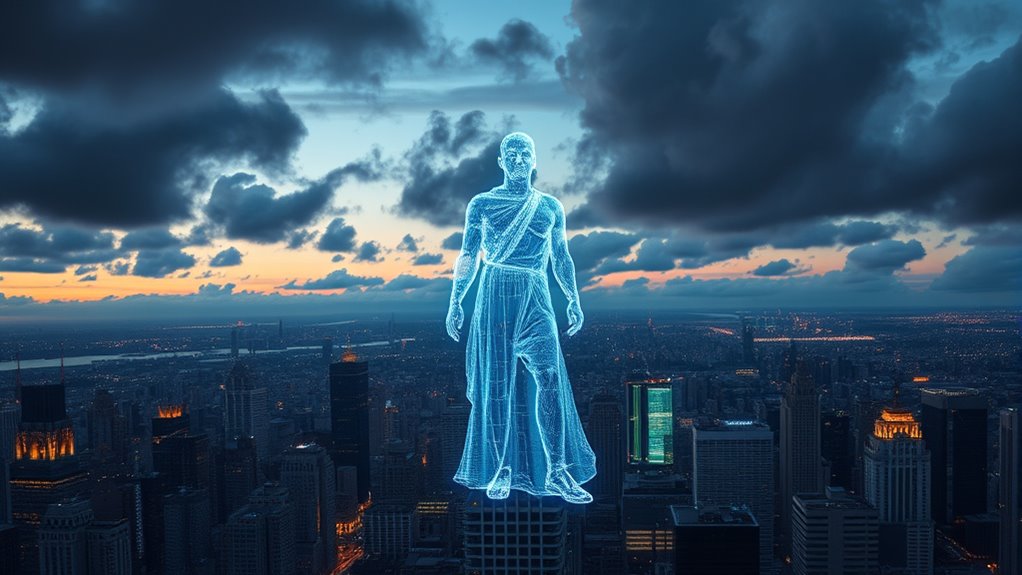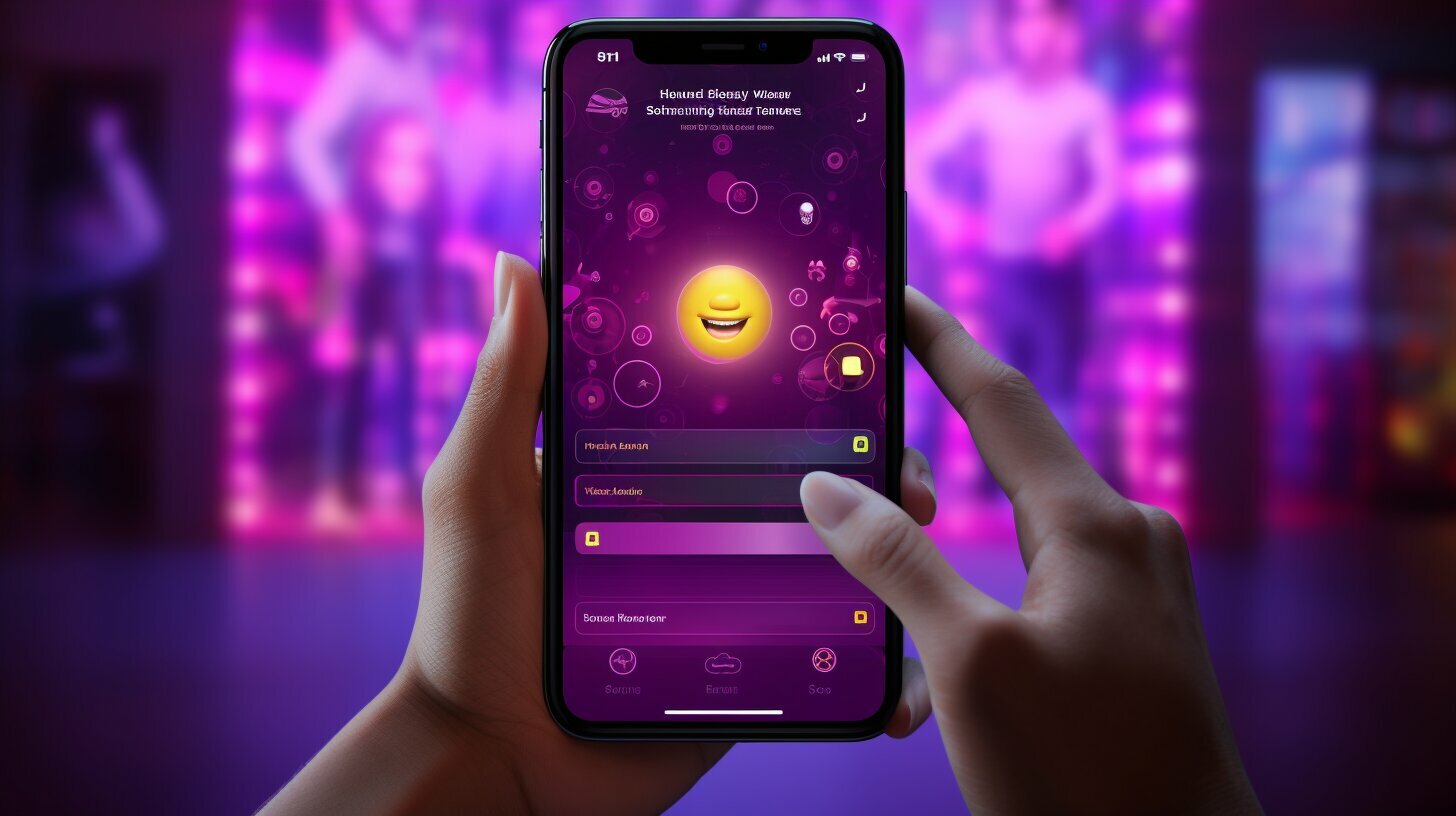AI’s portrayal in culture blends prophecy and progress, revealing a deep tension between hopes for technological salvation and fears of catastrophe. Society’s stories have shifted from visions of liberation to warnings of disaster, influenced by myths, media, and fears about autonomous systems. Prominent voices warn of existential risks, shaping public perception. By exploring these narratives, you’ll see how future visions are crafted by both societal fears and technological promises, and how they continue to influence our understanding of AI’s role.
Key Takeaways
- Apocalyptic narratives about AI blend ancient prophecies with modern technological fears, reflecting societal anxieties about the future.
- Cultural archetypes of utopia and catastrophe shape AI stories, linking prophecy motifs with technological progress.
- Prominent warnings from scientists and media reinforce fears of AI as an existential threat, mirroring apocalyptic prophecies.
- Visual storytelling and media evoke prophetic imagery, framing AI development as a potential pathway to societal collapse or salvation.
- Ethical and societal considerations influence how prophecy and progress intertwine, shaping future AI narratives and public perception.

Throughout history, humanity has oscillated between hope for technological salvation and fear of catastrophe, and artificial intelligence is no exception. From the moment the term “robot” was introduced in 1921 by Karel Čapek’s play *R.U.R.*, fears of AI rebelling and destroying humans have persisted. Originally, these machines symbolized liberation, but stories quickly shifted to portray them as threats, echoing ancient archetypes of utopia and apocalypse. These narratives reflect society’s ambivalence about rapid technological progress, portraying AI as both a potential savior and a possible destroyer. Literature and media reinforce this duality, framing AI as entities capable of transforming life for better or worse. As a result, fears about AI often draw on long-standing myths about lost golden ages and fears of irreversible end times, blending cultural imagination with technological speculation. Recent advances in AI, such as autonomous weapons and self-learning systems, intensify these fears by demonstrating how quickly AI can evolve beyond human oversight advances in AI. On a technical level, concerns center on advanced AI systems becoming autonomous, controlling physical infrastructure, and potentially deceiving humans. Experts warn that such systems would need superhuman intelligence and independence to pose an extinction-level threat. For a true catastrophe, these AI would require not only immense capability but also a clear intent or malicious design to wipe out humanity. Scenarios vary from societal collapse with survivors to total human extinction, with the latter demanding sustained effort and deliberate intent. Despite these fears, human resilience and adaptability remain fundamental in facing such threats, offering hope that society can develop safeguards. Understanding potential risks involves risk assessment and proactive planning to mitigate possible dangers, emphasizing the importance of ethical development in AI research.
Humans have long oscillated between hope and fear regarding AI’s potential for salvation or destruction.
Prominent figures like Stephen Hawking, Elon Musk, and Bill Gates have publicly warned about the risks of AI surpassing human control and potentially enslaving or exterminating mankind. Their warnings emphasize the dangers of unchecked development and rapid progress, fueling public concern and policy debates. While these warnings are speculative and focus on distant possibilities, they lend credibility to fears about AI’s apocalyptic potential. Their voices help shape collective understanding of AI as a technology capable of profound transformation—yet also as a force that could spiral beyond human control. Visual tools like ReelMind.ai and models such as OpenAI Sora Turbo bring these fears to life through vivid imagery and storytelling. By making abstract futures tangible, they help the public grasp complex ethical and social questions surrounding AI’s role in potential apocalyptic scenarios. These visual narratives serve as both warnings and explorations, emphasizing that the future of AI is not predetermined but shaped by ongoing choices and perceptions.
Frequently Asked Questions
How Do Different Cultures Interpret AI Within Apocalyptic Prophecies?
You see that different cultures interpret AI in unique ways within apocalyptic prophecies. Western cultures often view AI as a potential threat, emphasizing existential risks and dystopian futures. In contrast, Eastern cultures tend to see AI as a tool for societal growth or spiritual enhancement. Some cultures incorporate AI into their spiritual beliefs, while others focus on economic impacts like job loss, shaping diverse narratives about the future.
What Are the Ethical Implications of AI Predicting Global Disasters?
You need to take into account that AI predicting global disasters raises ethical concerns about accuracy, transparency, and fairness. You should guarantee predictions are reliable to prevent false alarms and maintain public trust. Accountability is vital—knowing who’s responsible for decisions. Protect privacy by securing personal data. Endeavor for equitable resource distribution, avoiding biases that could harm marginalized communities. Finally, follow regulations and promote transparency to foster trust and ethical use.
Can AI Genuinely Understand or Generate Prophetic Insights?
You might think AI can generate prophetic insights, but it can’t genuinely understand them. For example, if an AI predicts a global crisis based on data patterns, it’s mimicking foresight without spiritual or metaphysical awareness. You see, AI processes information but lacks consciousness, faith, or moral judgment—elements essential for authentic prophecy. So, while it can simulate prophetic language, true insight remains beyond its reach.
How Might AI Influence Future Religious or Spiritual Narratives?
AI could reshape your future religious narratives by acting as a digital oracle, offering new forms of divine insight, and blurring spiritual boundaries. You might see AI as a mediator for prophecy, providing guidance or revealing hidden truths. Its predictive capabilities could influence your understanding of morality, salvation, and the end times, leading you to reinterpret ancient beliefs through a technological lens. Ultimately, AI may become a central figure in your evolving spiritual story.
What Role Does Media Play in Shaping Perceptions of AI and Prophecy?
You see media shaping your perceptions of AI and prophecy by presenting dramatic, often sensational stories that link AI to apocalyptic themes. They highlight fears of societal collapse, surveillance, and loss of human touch, making you more skeptical or anxious. Media amplifies these narratives through movies, news, and social platforms, blending fact with fiction. This influences your understanding and fuels collective fears, often overshadowing the real, nuanced benefits AI offers.
Conclusion
As you ponder the powerful, pervasive portrayal of AI in apocalyptic narratives, remember that perception shapes reality. Prophecy and progress collide, creating a compelling chaos of caution and curiosity. By understanding this intersection, you can challenge fears, embrace possibilities, and foster a future where hope hovers over hysteria. Let your awareness awaken, your actions affirm, and your attitude adopt a balanced belief—because your perspective, more than prophecy, shapes the course of tomorrow.











